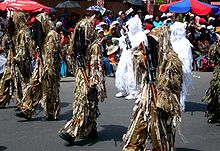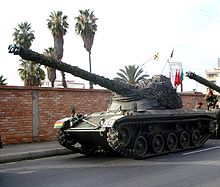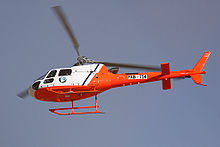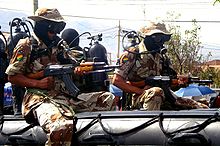- Military of Bolivia
-
Military of Bolivia 
Service branches Army (Ejército Boliviano),
Navy (Fuerza Naval Boliviana,
Air Force (Fuerza Aérea Boliviana),
National Police Force (Policía Nacional de Bolivia)Manpower Military age 18 Available for
military service1,949,267, age 15–49 (2000 est.) Fit for
military service1,269,228, age 15–49 (2000 est.) Reaching military
age annually86,863 (2000 est.) Active personnel 55,500[1] Expenditures Budget $147 million (2006) Percent of GDP 1.9% (2006) Industry Foreign suppliers  Venezuela
Venezuela
 Brazil
Brazil
 Russia
Russia
 United States
United StatesThe Bolivian Armed Forces are the military of Bolivia.
Contents
Army
The Bolivian Army has around 55,500 men. There are six military regions (regiones militares—RMs) in the army. The Army is organized into ten divisions. The Army maintains a small fleet of utility aircraft, primarily to support headquarters.
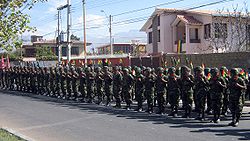 Soldiers in Cochabamba before a parade.
Soldiers in Cochabamba before a parade.
Combat units directly under the Army general command
- RI 1 Colorados(Presidential guard),BTQ-261 Calamus(armour),GRM-221 Tarapaca (mech.),GCM-224 Ingavi (armour cavalry),RAA-236 G.B.B. Rioja (AA regiment),BATCOM-251,Gen.maintenance cen.no1,transport batt. no1.
Special forces command
RI 12 Manchengo (ranger) Montero, RI 16 Jordan (special forces)Riberalta, RI 24 M.Arcos (ranger)Challapata.
Army aviation command
Army aviation company 291 (La Paz), army aviation company 292 (Santa Cruz).
Regional
The Bolivian Army has six military regions (regiones militares—RMs) covering the various Departments of Bolivia:
- RM 1, La Paz, most of La Paz Department,1.Division army,BPM-271 C.L.Savedra (batt.MP),BE-296 CNL R.C.Zabalegui(ecological batt.),BE-297 (ecolog. batt.),BATLOG-1 (long. batt),army aviation company 291 C.L.Cordoba,mili. hospital no1,mili.police school,riding school,engineers school,army military academy CNL G.Villaroel,intelligence school MCAL Sucre,school communications.
- RM 2, Potosi ,covering the departments of Oruro and Potosi:2.Division army,10.Division army,RI 24 M.Arcos (ranger batt.),ADA-202 (a.a. group), climbing military school.
- RM 3, Tarija, consisted of Tarija Department and eastern Chuquisaca and sauthern Santa Cruz:3.Division army,4.division army.
- RM 4, Sucre, covering the departments of Cochabamba and northern Chuquisaca: 7.Division army,BMP-272 (batt.MP),BATLOG-2 (long.Batt),mili.hospital no2,central arsenal,school of command and staff MCAL.A.Santa Cruz,sergeants mili.school,train.center for special troops,artillery school.
- RM 5, Cobija, encompassed Pando Department and parts of La Paz and Beni departments: 6.Division army,RI 16 Jordan (special forces),train.centar in forest operation (CIOS I) and (CIOS II).
- RM 6, Santa Cruz, covering most of Santa Cruz Department: 5.Division army,8.Division army,BMP-273 R.Amezaga (batt.MP),BE-298 (ecological batt.),RI 12 Manchego (ranger),BATLOG-3 (longist. batt.),292 army aviation company,Condors sschool Bolivianos (special force).
The army was organized into ten territorial divisions, each of which, with the exception of Viacha, occupied a region generally corresponding to the administrative departments, with some overlapping. Their division headquarters were located in:
- 7.Cochabamba (the largest):,RI 2 Sucre,RI 18 Vitria (airborne),RI 26 R.Barrientos (mech.),RI 29 CTN:V:Ustariz (airborne),RA 7 Tumusia,Bat.Ing.5 T.N.Ovando
- 4.Camiri (Santa Cruz Department):,RI 6 Field,RI 11 Boqueron,RC 1 Avaroa,RA 4 Bullian
- 2.Oruro:RI 21 Illimani(Mountain),RI 22 Mejillones,RI 25 Tocopilla ,RC 8 Braun ,RA 1 Camacho,Bat.Ing. 7 Sajama.
- 10.Tupiz: RI 3 Perez,RI 4 Loa,RI 27 Antofagasta,RC 7 Chichas (mech.),RA 12 Ayohuma (reserve)
- 5.Roboré (Santa Cruz Department): RI 13 Montes,RI 14 Florida,RI 15 Junin,RC 6 Castrillo,RA 5 Vergara
- 9.Rurrenabaque,the Division has been reduced to reserve status and its component units have been divided up between DE-1 and DE-6
- 8.Santa Cruz: RI 7 Marzana,RI 10 Warnes (mech.),RC 10 G.M.J.M. Market,RA 9 Mitre, (reserve),Bat.Ing. 3 Pando.
- 6.Trinidad,RI 17 Indepedencia,RI 29 Echevarria,RI 31 Rios,RI 32 Murguia,RC 2 Ballivan,RA 8 Mendez(reserve),Bat.Ing. 6 Riosinho.
- 1.Viacha (La Paz Department),RI 8 Ayacucho,RI 23 M.Toledo (mech.),RI 30 Murillo (mauntain),RC 5 J.M.Lanza,RA 2 Bolivar,Bat.Ing. 2 G.F.Roman.
- 3.Villamontes (Tarija Department),RI 5 Capero,RI 20 Padilla,RC 3 Aroma,RA 3 Pisagua,Bat.Ing. 1 Chorolque.
RI: infantry regiment RC: cavalry regiment RA: artillery regiment Bat.Ing.: battalion engineer
Army organized has ten divisions controlling the following units:
- eight cavalry regiments, included two mechanized regiments
- twenty-tree infantry regiments included two airborne and two mauntain
- one recce.mechanized regiments and one armored regiments
- two ranger regiments and one special forces regiments
- six artillery regiments and plus three in reserve
- one artillery and antiair group
- one artillery and antiair Regiment
- three military police battalion
- three ecological battalion
- two army aviation company
- six engineer battalions
- Plus logistical and instructional support commands
- Presidential Guard (Colorado) infantry battalion under direct control of the army headquarters in La Paz's Miraflores district
The Army maintains a small fleet of utility aircraft, primarily to support headquarters.
Land Forces Equipment
 Towed artillery piece before a parade in Cochabamba.
Towed artillery piece before a parade in Cochabamba.
Bolivian army equipment[2] Tanks 36 SK-105 Kurassiers Reconnaissance vehicles 24 EE-9 Cascavel Armoured Personnel Carriers 50 M113 armored personnel carriers with local upgrades], 24 EE-11 Urutu APC,24 M9 Semiorugas APC , 10 Cadillac Gage Commando V-150, 20 Mowag Roland local upgraded (Used |by the military Police) Artillery pieces and mortar 18 Type 54 122mm howitzers, 6 M101 105mm howitzers, 10 Pack 75mm howitzers, 6 Bofors L/40 M-1935 75mm howitzers. Mortars: M 120 120mm, M30 107mm mortars, 250 M29 81mm mortars,FM 81mm,W87 81mm, M-224 60mm mortars AA artllery: 16 2x37mm Type 65,80 2x20mm Oerlikon K20,50 MANPAD HN-5 AT weapons:rocket launchers RPG-7,RL 200 66mm M-72A3 LAW,RL 90mm M 20A1,recoilless cannon 90mm M-67,RCL 82mm Type 65/78,RCL 106mm M40A1,40 portable AT missile HJ 8AiB Red Arow
Transport TRANSPORT:DongFeng EQ 2081/2100,FEW C A1122J,Stayer 1491,16 Ford F-750,Unimog 416Dodge M-37 2 1/2 ton trucks, Engesa EE-15 trucks, Engesa EE-25 trucks, FIAT IVECO 619 5 ton trucksTACTICAL TRANSPORT VEHICLES:30 M988 HMMWV,40 Koyak local productionUTILITY TRANSPORT VEHICLES:Ford M151 MUTT jeep,CJ-5,CJ-7,Chrysler jeeep Wrangler,BJ 2020VJ, horses (still used by the Bolivian cavalry units) [2] Small Arms HANDGUNS: FN-35,glok 17,Ber.mod. 92F,S@M mod.10 all 9mm,M1911A1 11,43 SMG: FMK 3,UZI,MAT 49 all 9mmRifle:Galil AR,M-16A1,M4A1,Steyer AUG A1,SA 80, all 5,56, FN-FAL,SIG-542,SIG_510-4, all 7,62mm,Type and 56–2(ak-47),SNIPER:Dragunov SVD,Mauser mod.86SR,Steyer SSG-69P1AM Rifles:Steyer HS 50 12,7mmMG:M 60,FN-MAG 60–20,SIG MG710-3 all 7,62mm,Type 56 LMGGl:Type 87 35mm,MM −1,m 79,M 203 all 40mmShotguns:Regminton 870 and 11–87. Uniforms
Army officers, NCOs, and enlisted personnel wear generally gray or, for tropical areas, gray-green service uniforms. Army fatigue uniforms were olive green, and combat uniforms were of US woodland pattern camouflage. The standard headgear for enlisted personnel is the beret bearing the national colors of red, yellow and green. Paratroops (paracaidistas) were distinguished by black berets, and Special Forces by green berets.
Aircraft Origin Type Versions In service[3] Notes Beechcraft King Air  United States
United StatesStaff transport Model 90
Model 2001
1Cessna 206 Stationair  United States
United StatesUtility 4 Cessna 421 Golden Eagle  United States
United StatesStaff transport Cessna 421B 1 CASA C-212 Aviocar  Spain
Spaintransport 1 Center of instruction of special troops Air Force
- See full article: Bolivian Air Force.
The Bolivian Air Force ('Fuerza Aérea Boliviana' or 'FAB') has nine air bases, located at La Paz, Cochabamba, Santa Cruz, Puerto Suárez, Tarija, Villamontes, Cobija, Riberalta, and Roboré.
File:006535CD.jpgK-8VB karakorum of the FABMajor commands included the following:
- General Command Systems Department in La Paz, equipped with sophisticated computers. In March 1989, FAB took a major step toward modernizing its force by inaugurating the
- Group of Security and Defense of Air Installations (Grupo de Seguridad y Defensa de Instalaciones Aéreas—GSDIA); and GADA-91, GADA-92, GADA-93 and GADA-94.
- Four air brigades with thirteen subordinate air groups.
 Two Pilatus PC-7 of the FAB.
Two Pilatus PC-7 of the FAB.
-
- First Air Brigade (El Alto):
- Hunting air group 31 "G.J.Market": Fighter squadron 311,Executive squadron 310
- Transport air group 71 "Gen.W.A.Rojas" (Military airlift TAM):Air squadron 710,Air squadron 711,Air squadron 712
- Aerophotogrammetry National Service (NSS)
- Bolivian Air Transport-TAB
- Task Force "Black devils"
- Group air defence artilllery GADA-91
- First Air Brigade (El Alto):
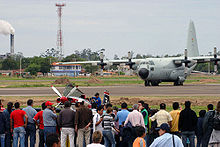 In front, an Extra 300, and behind, a C-130 Hercules of the FAB.
In front, an Extra 300, and behind, a C-130 Hercules of the FAB.
-
- Second Air Brigade (Cochabamba):
- Hunting air group 34 "P.R.Cuevas": Aerotactico squadron 340,Link training squadron 341
- Group air search and rescue 51: Squadron helicopter 511
- Group air defence artillery GADA-92
- Third Air Brigade (Santa Cruz):
- Hunting Air Group 32 "B.B.Rioja": squdron 321,squadron 320,squadron 327 (maintenance)
- COLMILAV Training squadrons: primary squadron,basic squadron,squadron "NN" (prob.navigation)
- Air group air reconnaissance and exploration 82(air base Puerto Suarez): 831 squadron
- Air group 61 "Gen.L.G.Pereiera (air base Puerto Suarez): squadron 610
- Task force "Red Devils" (air base The Trompillo-Robore)
- Group air defence artillery GADA-93
- Fourth Air Brigade:
- Group air reconnaissance and exploration 82 "Cap.A.V.Peralta" (air base Tarija): squadron 821
- Air Group 63 "Tcnl.E.L.Rivera" (air base Villamontes): squadron 630
- Group air defence artillery GADA-94
- Second Air Brigade (Cochabamba):
Units under direct control of the general command of the FAB
-
-
- Tactical air group 62 (air base Riberalta): squadron 620
- Air group 64: squadron (air base Cobija) 640
- Transport air group 72 (air base Trinidad) : squadron 720
-
 UH-1H Huey National Institute of Civil Aeronautics Helicopter.
UH-1H Huey National Institute of Civil Aeronautics Helicopter.
- See full article: Bolivian Naval Force.
The Bolivian Naval Force (Fuerza Naval Boliviana in Spanish), formerly Bolivian Navy (Armada Boliviana) is a naval force about 5,000 strong in 2008.[4] Although Bolivia has been landlocked since the War of the Pacific in 1879, Bolivia established a River and Lake Force (Fuerza Fluvial y Lacustre) in January 1963 under the Ministry of National Defense. It consisted of four boats supplied from the United States and 1,800 personnel recruited largely from the army. Bolivia's naval force was renamed the Bolivian Naval Force (Fuerza Naval Boliviana) in January 1966, but it also has been called the Bolivian Navy (Armada Boliviana). It became a separate branch of the armed forces in 1963. Bolivia has large rivers that are tributaries to the Amazon which are patrolled to prevent smuggling and drug trafficking. There is also a Bolivian Naval presence on Lake Titicaca, the highest navigable lake in the world, across which runs along the Peruvian frontier.
Landlocked Bolivia has not become reconciled with the loss of its coast to Chile, and the Navy exists to keep the hope of recovering its coast alive by cultivating a maritime consciousness.[citation needed] The Bolivian Navy takes part in many parades and government functions, but none more so than the Día Del Mar (Day of the Sea) in which Bolivia, every year, asks for the coast territories lost to Chile during the War of the Pacific (fought between Peru and Bolivia against Chile) from 1879 to 1884. This is still a sore point for Bolivia, influencing many modern-day political actions and trade decisions.
Districts
The Navy is organized into ten naval districts, with flotilla headquarters in Guaqui, Guayaramerín, Puerto Suarez, Riberalta, and San Pedro de Tiquina, and bases in Puerto Busch, Puerto Horquilla, Puerto Villarroel, Trinidad, and Rurrenabaque.
Naval vessels include several dozen boats, dozen or more of which are for riverine patrol, including the piranias, and riders, which are powerful river boats. In addition, Bolivia has several seagoing vessels, including the Santa Cruz de la Sierra (PR-51), and several flagged ships that sail with the permission of the "Capitanias Navales" Naval Registration Office. The Libertador Simón Bolívar, a ship acquired from Venezuela, use to navigate from its home port in Rosario, Argentina on the River Paraná. In 1993, the Navy was formally renamed the Naval Force (Fuerza Naval) and moved with the Bolivian Army under a single military authority.
Most of the officers are often educated in the Naval Academy where they graduate with a BS in Military and Naval Science, diploma accredited by the Military University and then they do other studies at the bachelor’s degree and master’s level. Argentina has their Naval Military Group in Bolivia advising at the highest level in naval strategy and tactics. Many Bolivian officers practice ocean sailing in Argentinean big naval ships. The Bolivian Navy has several Special Forces units to address both internal and external conflicts. La Fuerza Naval Boliviana cubre el extenso territorio fluvial y lacustre boliviano dividiendo sus funciones entre los siguientes Distritos Navales, nótese que los nombres de estas unidades derivan de la cuenca fluvial o región en la que operan: Bolivian Naval Force covers the extensive river and lake Bolivian territory divided between the following functions Naval Districts, note that the names of these units are derived from the basin or region where they operate:
-
- DN1 Primer Distrito Naval "BENI"- DN1 First Naval District "BENI"
- DN2 Segundo Distrito Naval- "MAMORE"- DN2 Second Naval District "MAMORA"
- DN3 Tercer Distrito Naval "MADERA" -DN3 Third Naval District "WOOD"
- DN4 Cuarto Distrito Naval "TITICACA" -DN4 Fourth Naval District Titicaca
- DN5 Quinto Distrito Naval "SANTA CRUZ DE LA SIERRA" -DN5 Fifth Naval District "SANTA CRUZ DE LA SIERRA"
- DN6 Sexto Distrito Naval "COBIJA" -Sixth Naval District DN6 "Shelter"
 Marines of Bolivia marching in Cochabamba.
Marines of Bolivia marching in Cochabamba.
-
- Besides the naval aereas:
-
-
- AN 1 "COCHABAMBA"- AN 1 "Cochabamba"
- AN 2 "SANTA CRUZ"- AN 2 "SANTA CRUZ"
- AN 3 "BERMEJO" -AN 3 "Red"
- AN 4 "LA PAZ" -AN 4 "PEACE"
-
-
- And the special units:
-
-
- Fuerza de Tarea "Diablos Azules"- Task Force "Blue Devils"
- Servicio de Inteligencia Naval – SINDA Naval Intelligence Service – SINDA
- Grupo de Reacción Inmediata GRIN -Immediate Response Group GRIN
- El Centro de Instrucción de Buceo en Altura- The Diving Training Center in Height
- Command Training Center Amphibians
-
Marine corps
The Marine component of the FNB originated with the creation of the Marine Battalion Almirante Grau in the early 1980s.This unit of 600 men is based on Tiquina naval base on Lake Titicaca.Later changes name to Marine Battalion Independence, based in Chua (Not to be confused with the Independence RI17 EB).At present this battalion maintains a similar number of troops including premilitares. Staff of this unit is part of Task Force Blue Devils or are stationed in various naval bases.There are currently seven infantry battalions which are distributed as follows:
- Primer Distrito Naval "BENI"- First Naval District "BENI"
- Batallón de Infantería de Marina I "Bagué"- Marine battalion I "Bagué"
- Segundo Distrito Naval "MAMORE"- Second Naval District "MAMORA"
- Batallón de Infantería de Marina II "Tocopilla"- Marine Battalion II "Tocopilla"
- Tercer Distrito Naval "MADERA"- Third Naval District "WOOD"
- Batallón de Infantería de Marina III "Mejillones"- Marine Battalion III "mussels"
- Cuarto Distrito Naval "TITICACA"- Fourth Naval District Titicaca
- Batallón de Infantería de Marina IV "Alianza " -Marine Infantry Battalion IV "Alliance"
- Batallón de Infantería de Marina Mecanizada VI "Independencia"- Marine Infantry Battalion Mechanized VI "Independence"
- Quinto Distrito Naval "SANTA CRUZ DE LA SIERRA"- Fifth Naval District "SANTA CRUZ DE LA SIERRA"
- Batallón de Infantería de Marina V "Calama"- Marine Battalion V Calama
- Sexto Distrito Naval "COBIJA"- Sixth Naval District "Shelter"
- Batallón de Infantería de Marina VII "Columna Porvenir"- Marine Battalion VII "Columna Porvenir"
This specialty is essentially similar to its counterpart in the Army, carrying out operations such as Important Persons Protection (IPP) Physical Security (SEF) or Patrol Facility (PAT), with additions such as signals or naval protocol.There Naval detachments of PM in all district headquarters or FNB Naval Area.But only have the following units at the Battalion:
- AN 4 " La Paz "- AN 4 "Peace"
- Batallón de Policía Militar Naval N° 1- Naval Military Police Battalion No. 1
- AN 1 "COCHABAMBA"- AN 1 "Cochabamba"
- Batallón de Policia Militar Naval N° 2 "Carcaje"- Naval Military Police Battalion No. 2 "Quiver"
- AN 2 "SANTA CRUZ"- AN 2 "SANTA CRUZ"
- Batallón de Policía Militar Naval N° 3 -Naval Military Police Battalion No. 3
- Cuarto Distrito Naval "TITICACA"- Fourth Naval District Titicaca
- Batallón de Policía Militar Naval N° 4- Naval Military Police Battalion No. 4
Strength
Boats
The Bolivian Navy has a total of 173 vessels, mostly stationed on Lake Titicaca:
- PATROL:
- 1 Class PR-51
- 6 class boats Cap. Bretel Bretel
- 4 patrol boats lake
- 32 Boston Whaler
- UNITS SALVAGE:
- 8 Piranha assault boats Mk.1
- 3 Boats hospitals
- 2 Transport of hydrocarbons
- 2 Tanker Ships
- 1 Transport
- 1 Ship "Naval School"[citation needed]
Bolivia's navy operates two utility aircraft for the use of headquarters.
Aircraft Origin Type Versions In service[3] Notes Cessna 206 Stationair  United States
United StatesUtility 206G 1 Cessna 402  United States
United StatesUtility 402C 1 Training installations
Training installations include the Garras International Antinarcotics Training School (Escuela Garras del Valor) is a military training facility located in Bolivia, which trains military and law enforcement personnel from Bolivia and other Latin American countries[citation needed] in counternarcotics, intelligence, and counterinsurgency techniques.[5][6][7]
See also
- List of wars involving Bolivia
References
- ^ What is the total active duty personnel for Bolivia? - Britannica Online Encyclopedia
- ^ a b http://www.saorbats.com.ar/ORBAT-Bolivia-%20EB.htm
- ^ a b "World Military Aircraft Inventory", Aerospace Source Book 2007, Aviation Week & Space Technology, January 15, 2007.
- ^ Carroll, Rory (August 28, 2008). "Bolivia's landlocked sailors pine for the high seas". The Guardian (London). http://www.guardian.co.uk/world/2008/aug/28/bolivia. Retrieved April 26, 2010.
- ^ "United States promotes rule of law, transparency in the Americas.". Embassy of the United States: Montevideo. May 26, 2005. http://montevideo.usembassy.gov/usaweb/paginas/400a-00EN.shtml. Retrieved 3 February 2010.[dead link]
- ^ "Andean Counterdrug Initiative: International Narcotics and Law Enforcement: FY 2002 Budget Justification". U.S. Dept. of State (official website). May 2001. http://www.state.gov/p/inl/rls/rpt/cbj/fy2002/3701.htm. Retrieved 3 February 2010.
- ^ Ledebur, Kathryn (September 4, 2008). "New York Times Misleads Readers on Drug War in Bolivia". Media Accuracy on Latin America. http://www.mediaaccuracy.org/node/64. Retrieved 3 February 2010.
- [1] - Order of battle and list of equipment used by the military of Bolivia.
This article was adapted from the CIA World Factbook 2000.
External links
Military of South America Sovereign states Dependencies and
other territories- Aruba
- Bonaire
- Curaçao
- Falkland Islands
- French Guiana
- South Georgia and the South Sandwich Islands
Categories:- Military of Bolivia
- Conscript militaries
Wikimedia Foundation. 2010.

